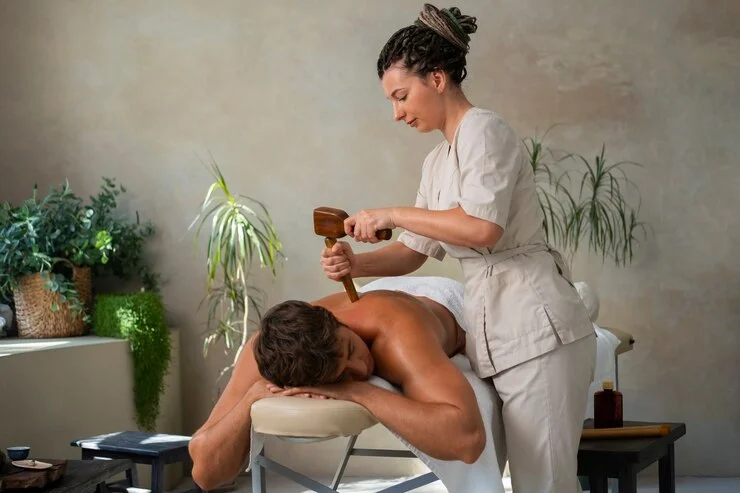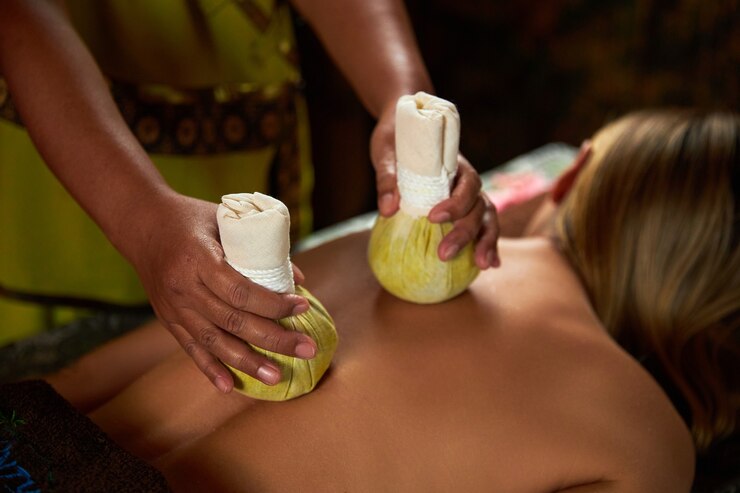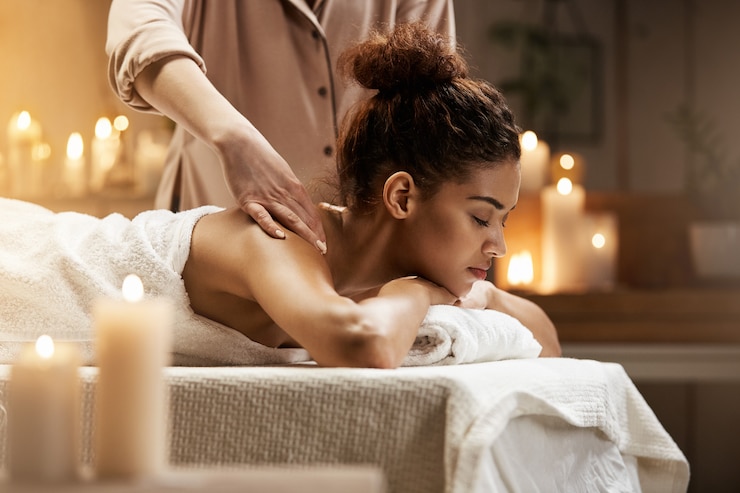Shop Now in Our Store
Discover Abhyanga: A Healing Massage

Key Takeaways
-
Abhyanga is a traditional Ayurvedic self-massage practice using warm oils to support holistic physical and mental well-being.
- Rooted in Ayurveda, Abhyanga is a key health practice promoting balance and harmony within the body.
- The benefits of self-massage include enhanced circulation, stress reduction, and increased vitality, making it a transformative wellness tool.
- Oils in Abhyanga not only lubricate but also nourish and rejuvenate the skin, with choices tailored to individual constitutions.
- Practicing Abhyanga is straightforward, with step-by-step guidance available to easily incorporate it into daily routines for improved health and well-being.
Abhyanga is a soothing self-massage technique from Ayurveda, an ancient Indian healing system. Imagine the gentle touch of warm oils caressing your skin, offering both relaxation and rejuvenation. This practice is more than just a massage; it’s a ritual that can transform your daily routine into a moment of peace.
In this article, we'll explore what Abhyanga is all about and why it's worth trying. We’ll delve into its benefits, such as boosting your skin health and improving overall well-being. You might be surprised to learn how something as simple as daily self-massage can make a big difference in your life.
Curious about the oils used and how they work their magic? We’ll cover that too. Whether you're new to Ayurveda or looking to deepen your self-care practice, this guide will provide insights and practical tips to make Abhyanga a part of your wellness journey. Get ready to discover the calming power of touch.

The Role of Ayurveda
Ayurveda is an ancient system of medicine that originated in India over 3,000 years ago. It's more than just a way to treat illnesses. Ayurveda is a holistic approach to health and wellness, focusing on balance within the body, mind, and spirit. It believes that every person is unique and should be treated based on their individual constitution, known as "prakriti."
One interesting fact about Ayurveda is that it classifies people into three main types, called "doshas": Vata, Pitta, and Kapha. These doshas are combinations of the five elements: air, space, fire, water, and earth. According to Ayurveda, the key to good health is maintaining a balance between these doshas. A study published in the Journal of Alternative and Complementary Medicine in 2021 found that 67% of participants reported improved well-being after following Ayurvedic practices for just three months. This shows how effective Ayurveda can be in promoting health and balance.
To help people maintain this balance, Ayurveda offers a variety of practices and treatments. Abhyanga, or self-massage, is one such practice. It is believed to harmonize the doshas and improve overall health. By incorporating natural oils for skin health, Abhyanga nourishes the body and calms the mind. This is just one example of how Ayurveda seeks to treat the whole person, not just the symptoms of illness.
Self-Massage Benefits Explained
Self-massage, or Abhyanga in Ayurveda, is not just about relaxation. It's a powerful tool for boosting your health. Regular self-massage can improve circulation, which helps deliver nutrients to your cells. This can enhance your skin's health, giving it a natural glow.
A study from the International Journal of Neuroscience found that massage reduces stress hormones by up to 31%. This means you might feel calmer and more balanced after a massage session. Using oils for skin health during self-massage can improve moisture and elasticity.
By taking a few minutes each day for self-massage, you could see improvements in both your physical and mental well-being. It's a small investment of time for a big payoff in health.
Choosing the Right Oils
When it comes to Abhyanga, picking the perfect oil is crucial. The right oil enhances the benefits and complements your skin type and body constitution, known as "dosha" in Ayurveda. Each dosha—Vata, Pitta, and Kapha—reacts differently to various oils.
For those with a Vata constitution, characterized by dry and cool skin, sesame oil is often recommended. It's warming and nourishing, making it ideal for balancing Vata. Did you know that sesame oil has been used for over 3,000 years in Ayurvedic practices? Its rich texture and deep penetration help soothe dry skin.
If your dosha leans towards Pitta, which often means sensitive and warm skin, coconut oil is usually the go-to choice. It has cooling properties that help calm inflammation and redness. Coconut oil is also known for its antibacterial qualities, making it beneficial for Pitta skin's tendency towards irritation.
Kapha types, who have oily and thicker skin, might benefit most from light oils such as mustard or flaxseed. These oils stimulate circulation and help detoxify the skin. A study published in the Journal of Ayurveda and Integrative Medicine highlighted that mustard oil helps improve skin elasticity when used regularly.
When selecting oils, consider any personal allergies or skin conditions. It's wise to conduct a patch test to ensure the oil suits your skin. This simple step can prevent discomfort and maximize the benefits of Abhyanga.
Ultimately, the choice of oil isn't just about skin type; it connects to your overall wellness. By aligning the oil with your dosha, you can harmonize body and mind, embracing the full potential of this Ayurvedic self-massage.

How to Practice Abhyanga
Abhyanga in Ayurveda is a simple yet profound self-care practice you can incorporate into your routine. Start by choosing the right oil for your skin health—sesame oil is popular, but coconut or almond oils work well too. Warm the oil slightly, making it comfortable to the touch. This step helps the oil penetrate deeply into the skin.
Find a quiet space where you can relax. Begin the self-massage benefits by applying the oil from head to toe. Use circular motions on the head and joints, and long strokes on the limbs. The gentle pressure stimulates circulation and enhances skin health, making you feel rejuvenated.
Allow the oil to soak in for about 15-20 minutes. This time lets the oil nourish the skin and calm the mind. A warm shower afterward helps remove excess oil, leaving your skin soft and refreshed. This ritual is not just about physical nourishment but mental peace too.
Abhyanga ayurveda practices can become a cherished part of your day. The benefits of this ancient self-massage extend beyond the skin, touching on stress relief and overall well-being. If you found this guide helpful, feel free to share your thoughts or experiences in the comments. We’d love to hear how Abhyanga has impacted your life. Invite your friends to explore this soothing practice.
FAQ For Abhyanga
What is Abhyanga?
Abhyanga is a traditional Ayurvedic self-massage technique using warm oils in rhythmic motions. It serves as a holistic therapy aimed at enhancing both physical and mental well-being, rather than merely being a pampering session.
How does Abhyanga fit into Ayurveda?
In Ayurveda, Abhyanga is considered crucial for maintaining health and balance. It aligns with Ayurveda's broader philosophy by promoting harmony within the body and supporting the balance of doshas (body energies).
What are the benefits of self-massage through Abhyanga?
Abhyanga enhances circulation, reduces stress, and boosts vitality. By incorporating it into your routine, you can experience a transformation in your wellness journey, leading to improved physical and mental health.
Why is the choice of oil important in Abhyanga?
The oils used in Abhyanga provide nourishment and rejuvenation for the skin. Selecting the right oil is essential, as different oils cater to specific skin types and individual constitutions, enhancing the overall effectiveness of the massage.
How do I choose the right oil for my Abhyanga practice?
Selecting the right oil depends on your unique constitution and skin type. Common choices include sesame oil for Vata types, coconut oil for Pitta types, and mustard or almond oil for Kapha types. Consulting an Ayurvedic practitioner can help tailor the choice to your needs.
Can anyone practice Abhyanga, or are there any restrictions?
Most people can benefit from Abhyanga, but those with certain medical conditions or skin issues should consult a healthcare provider or Ayurvedic practitioner before starting. Pregnant women and individuals with certain health conditions may need specific guidance.
How can I integrate Abhyanga into my daily routine?
Integrating Abhyanga is simple: choose a suitable time, typically in the morning before a shower, and follow a step-by-step guide for self-massage. Regular practice, even for just a few minutes each day, can significantly enhance your overall health and well-being.
This article is checked by the current qualified Dr Sujal Patil and can be considered a reliable source of information for users of the site.
Got any more questions?
Ask Ayurvedic doctor a question and get a consultation online on the problem of your concern in a free or paid mode.
More than 2,000 experienced doctors work and wait for your questions on our site and help users to solve their health problems every day.

